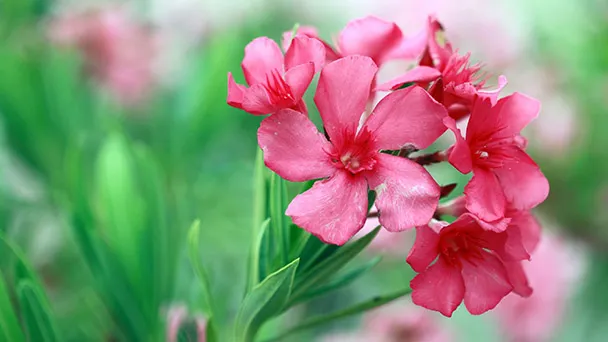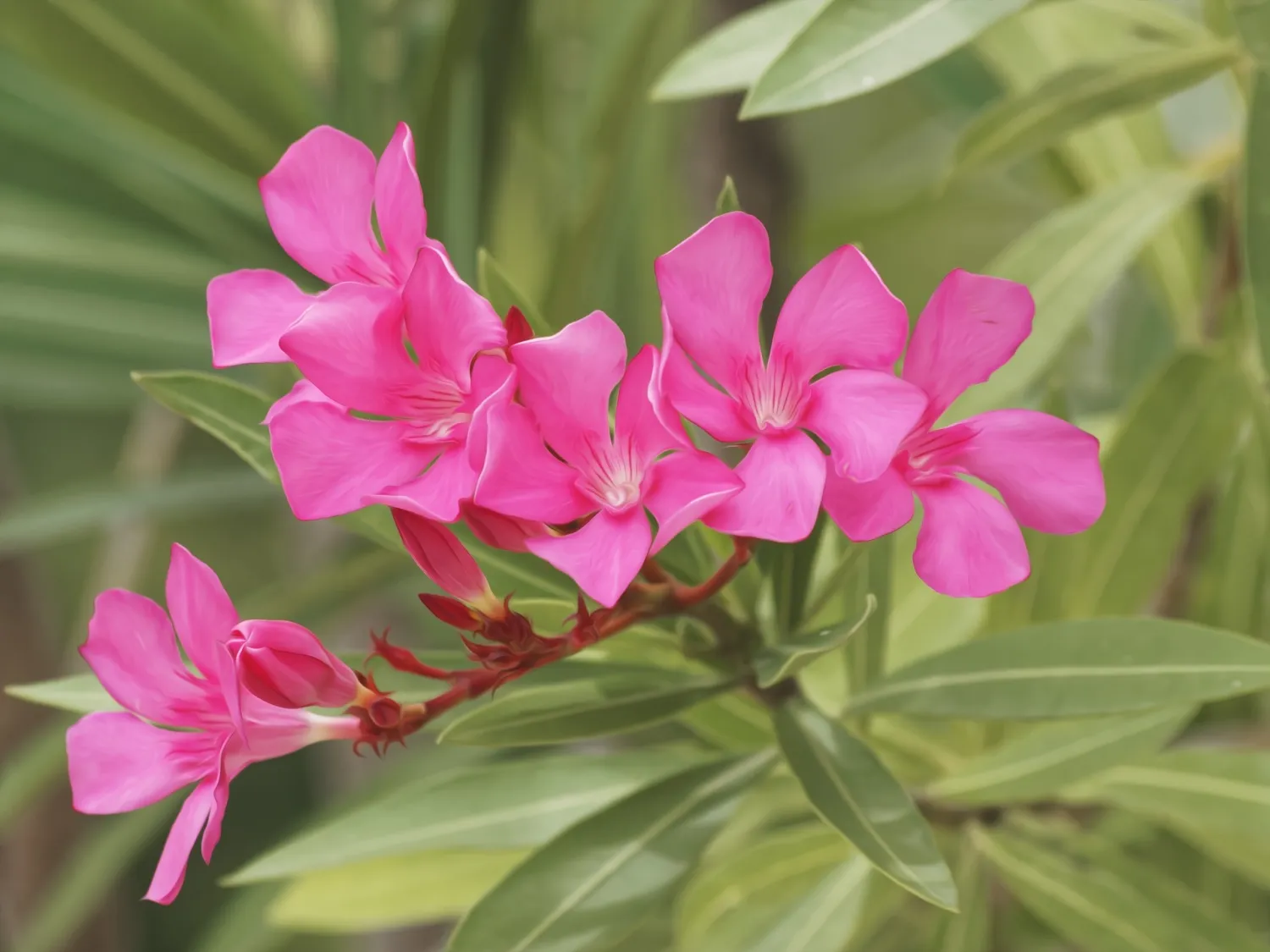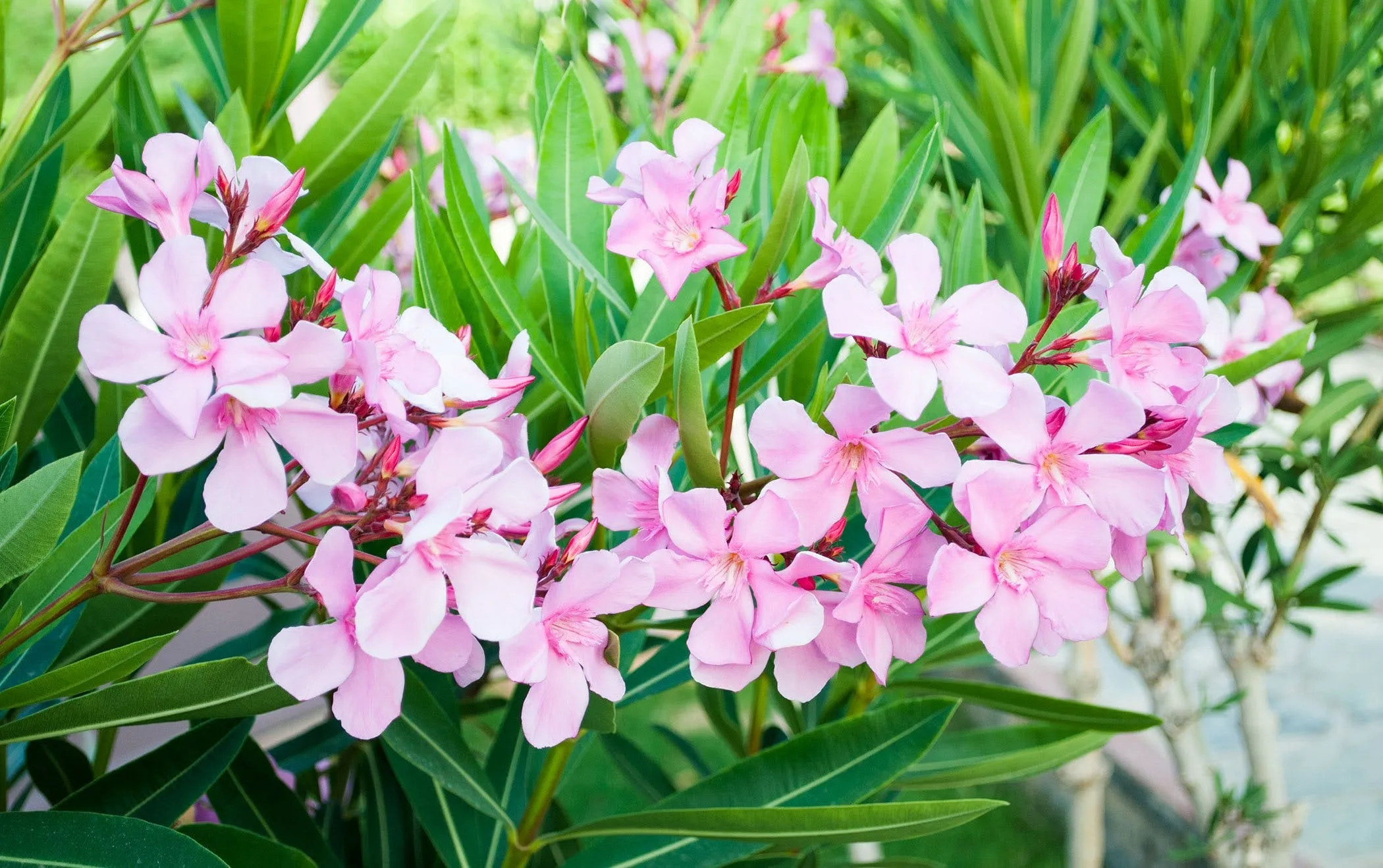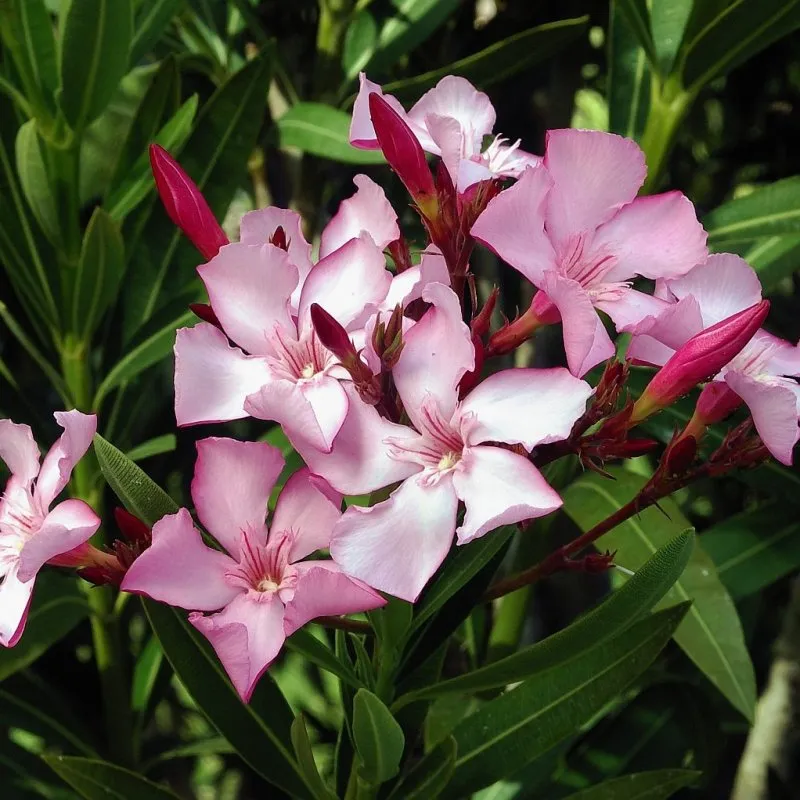How to Plant and Care for Oleander Plant (Nerium Oleander)
Written by Ivy
Nov 18 2021

Oleander plant (Nerium Oleander) is a large evergreen upright shrub, which can be 5 meters high. Oleander plant's branches are gray green, its young branches are crisped, its leaf surface is dark green and its back is light green. Oleander plant blooms all year round, the most lush in summer and autumn, with large, gorgeous and long flowering period, which is used for viewing. Oleander plant is highly toxic, and human and livestock can die by ingestion. When people grow oleander plants, they should be placed in sufficient sunshine, cold proof in winter and indoors at zero centigrade.

The weather is too hot in summer. When the temperature rises to a certain height, the plant will enter a dormant state, and the water required by oleander plant will be reduced. It likes light and is not resistant to water and humidity, so it can apply a small amount of water. Watering is best carried out in the morning and evening, 8 a.m. and 17 p.m. The temperature is not high in these two times. Before the flowers bloom, watering less than usual can promote the flowers to bloom.
In winter, the temperature becomes cold, and oleander plant has poor moisture resistance. The water needed by the plant is also decreasing, and it will enter the dormant state in winter, and the amount of water required will be less. We should choose noon to water the oleander plant in winter. Noon is the time of the highest temperature in the day, which is more suitable for the plant to avoid freezing its roots.
Oleander plant has a long flowering period and blooms almost all year round, so the flowering nutrients are essential. We can apply more phosphorus fertilizer during flowering, which can not only promote the flourishing of flowers and leaves, but also ensure the healthy growth of plants. Generally, topdressing is carried out every 10 days and half a month. It can fully supplement the nutrients needed by the plant, so that the plant can grow healthily and bloom vigorously.
When the oleander plant moves the basin in spring, it is necessary to apply sufficient base fertilizer, and then it is best to make thin fertilizer once a week. It is mainly composed of fertilizer rich in potassium and phosphorus, which can promote its rapid growth and improve the survival rate. After the survival of oleander plant, reduce fertilizer application and change fertilizer varieties at intervals. Most of them are fertilizers that promote growth and flower growth.

When we are giving oleander plant propagation from cutting, we should choose a suitable seedbed. Generally speaking, we'd better choose some sunny and dry places without diseases, pests and weeds, and then choose some fertile, loose and sandy soil with good air permeability, and then disinfect the soil.
When selecting oleander plant cuttings, we'd better select some strong and sunny branches in the middle and upper part, and then cut them. Generally speaking, select some thick branches with a diameter of 1 ~ 1.5 cm, with a cutting length of 15 ~ 20 cm, and then take two or three buds on the branches. Such oleander plant cuttings are easier to survive.
First, we disinfect the soil, then pour water into the cutting bed, and then insert the prepared cuttings into the seedling bed according to a certain spacing. However, when cutting the oleander plant, we must pay attention to the two ends of the cuttings and the upper and lower ends of the cuttings. We can't reverse the cuttings. Generally, it's appropriate to expose one or two buds on the soil.
Oleander plant can be sown in spring and summer. The seeds are sown in the plain sandy soil in a shallow basin. After a thin layer of soil is covered, spray them with a fine hole watering can for water penetration. Later, spray them every day to keep the soil moist. They germinate in 40 days at room temperature of 10 ℃ and emerge in succession in 20 days at 25 ℃.
Oleander plant seedlings can be separately planted in the pot when they grow to 3 ~ 4 true leaves and are 3 cm high. The seedlings grow slowly in the young seedling stage and then accelerate their growth. They usually bloom in 16 months. In order to make the seedlings grow quickly, they can be moved to the open field for cultivation and then put into the pot after it is cold.
The stems, leaves and flowers of oleander plant are toxic, and the leaves have a strong effect. The main toxic components are cardiac glycosides. The toxic reaction of oleander plant is similar to digitalis, mainly manifested in gastric and intestinal disorders. In severe cases, there are cardiotoxic reactions such as atrioventricular block and sinus tachycardia. However, the toxicity of oleander plant is lower than that of digitalis, which may be related to rapid excretion and weak accumulation. Its toxicity can also be different due to the collection time and the choice of old and tender leaves. Generally, more than 10 fresh leaves can be poisoned.
Oleander Plant Quick InfoWhen to Plant Oleander PlantWhen does Oleander Plant Bloom & HarvestOleander Plant Care in DetailOleander Plant WateringOleander Plant SoilOleander Plant LightOleander Plant TemperatureOleander Plant HumidityOleander Plant FertilizerOleander Plant PruningOleander Plant RepottingOleander Plant Pest & Disease ControlCercospora Leaf SpotWitches' BroomBlack SpotOleander Plant PropagationOleander Plant Propagation from CuttingOleander Plant Propagation from SeedOleander Plant Risks & Benefits
Oleander Plant Quick Info
| Botanical/Scientific Name | Nerium Oleander |
| Common Name | Oleander Plant |
| When to Grow/Bloom/Harvest | Plant in the early spring/Bloom in late summer |
| Uses | Heart conditions, asthma, epilepsy, cancer |
| Origin | North Africa and the eastern Mediterranean regions |
| Light Care | Bright light with at least 4 hours of direct sun each day |
| Soil Care | Soil-based compost |
| Temperature Care | No lower than 15 to 20 degrees F. (10 to -6 C.) |
| Humidity Care | Around 40% relative humidity |
| Watering | 1 to 2 inches of water each week |
| Pruning Care | Annual pruning of Oleander plant |
| Fertilizer Care | 10-10-10 granular fertilizer |
| Propagation | Cuttings |
| Toxic | All parts of the oleander plant are toxic |
| Flower Color | Orange, pink, red, white and yellow |

When to Plant Oleander Plant
Oleander plant is best planted in spring or autumn with appropriate temperature and humidity. Planting oleander plant can get excellent results and the survival rate is quite good. Oleander plant is a plant with strong adaptability. It can grow in both sunshine and dry places.When does Oleander Plant Bloom & Harvest
The flowering season of oleander plant is usually in summer and autumn, specifically from June to October. The flowering period of oleander plant is also relatively long. If it is properly maintained, it can be seen in almost all seasons. After flowering, we should provide a suitable environment according to the growth habits of oleander plant. It likes light. During flowering, it should ensure sufficient light and more sun. We also need to trim the oleander plant in time to cut off the aged branches and save nutrients. Just leave strong branches, so that the flowering period of oleander plant will be prolonged and the number of flowers will be more in the coming year.Oleander Plant Care in Detail
Oleander Plant Watering
In spring, the water requirement of oleander plant is relatively large, which is related to plant growth. Watering in spring is generally carried out around 9 a.m. and around 16 p.m. in the afternoon. Especially in early spring, when the weather is cold, we should pay attention not to frostbite the plants.The weather is too hot in summer. When the temperature rises to a certain height, the plant will enter a dormant state, and the water required by oleander plant will be reduced. It likes light and is not resistant to water and humidity, so it can apply a small amount of water. Watering is best carried out in the morning and evening, 8 a.m. and 17 p.m. The temperature is not high in these two times. Before the flowers bloom, watering less than usual can promote the flowers to bloom.
In winter, the temperature becomes cold, and oleander plant has poor moisture resistance. The water needed by the plant is also decreasing, and it will enter the dormant state in winter, and the amount of water required will be less. We should choose noon to water the oleander plant in winter. Noon is the time of the highest temperature in the day, which is more suitable for the plant to avoid freezing its roots.
Oleander Plant Soil
When we propagate oleander plant, we should plant it in the leeward and sunny place, and the room temperature should not be lower than 0 ℃. If the temperature is too high, nutrients will be consumed, which is unfavorable to the growth and flowering in the second year. In winter, those with high outdoor temperature can cultivate soil to keep out the cold. In areas with - 5 ℃ low temperature, the oleander plant must also be excavated in the late autumn, planted in pots, then moved into the low-temperature room, and then moved to the outdoor sunny place in late April of the next year.Oleander Plant Light
Oleander plant likes warmth and sunshine. In spring, we need to add light to oleander plant. First, we need to meet its light needs, but to increase the maintenance temperature. Oleander plant is a green plant with a large demand for light. Especially in spring, it is the growth period of oleander plant. It needs enough light to metabolize normally and grow fast. However, the amount of light does not need to be too much. It can be guaranteed for five hours a day.Oleander Plant Temperature
Oleander plant will stop growing when it is below five degrees, and will be frostbitten when it is below zero. The temperature in spring is unstable and the climate changes rapidly. Therefore, the maintenance temperature should be reasonably controlled, and the growth temperature should be controlled at about 15 degrees. In case of open field maintenance, the plant shall be wrapped with straw and other cold resistant materials to avoid being frostbitten by spring cold. If possible, oleander plant can be maintained indoors, and then maintained on the open ground when the climate is stable.Oleander Plant Humidity
Oleander plant prefers light, warm and humid climate, and is not resistant to low temperature. Oleander plan has good drought resistance, low requirements for soil quality, and can grow normally on alkaline soil.Oleander Plant Fertilizer
Oleander plant naturally likes light and fertilizer. Neutral or slightly acidic soil is very suitable for its growth. Oleander plant has large plants and long flowering period, so it naturally requires higher fertilizer nutrients. We can mainly use potassium fertilizer rich in plant growth elements.Oleander plant has a long flowering period and blooms almost all year round, so the flowering nutrients are essential. We can apply more phosphorus fertilizer during flowering, which can not only promote the flourishing of flowers and leaves, but also ensure the healthy growth of plants. Generally, topdressing is carried out every 10 days and half a month. It can fully supplement the nutrients needed by the plant, so that the plant can grow healthily and bloom vigorously.
When the oleander plant moves the basin in spring, it is necessary to apply sufficient base fertilizer, and then it is best to make thin fertilizer once a week. It is mainly composed of fertilizer rich in potassium and phosphorus, which can promote its rapid growth and improve the survival rate. After the survival of oleander plant, reduce fertilizer application and change fertilizer varieties at intervals. Most of them are fertilizers that promote growth and flower growth.
Oleander Plant Pruning
In July and August, we will comb, cut and prune the oleander plant to remove the root hair around the plant. After October, we will mainly use light cutting to shape the plant again. In this way, oleander plant can absorb more nutrients, make branches evenly distributed, with large flowers, beautiful tree shape and more lush growth. Because the top part of oleander has the characteristics of one to three branches, everyone can fix it according to their own preferences. Every time the oleander plant is trimmed, wait until it blooms. 5、 Timely prune branches and roots. The capillary roots of oleander plant grow rapidly. Three years later, they are planted in a basin with a diameter of 20 cm. Before July, the roots will grow full and spherical, and the growth will be affected because water and fertilizer cannot penetrate.
Oleander Plant Repotting
Oleander plant repotting is carried out in autumn, spring and rainy season. Although oleander plant is easy to survive, it can promote its survival and growth if it is transplanted with soil balls. When planting, we should remove 1 / 3 ~ 1 / 2 of the branches and leaves, or cut off the branches. We can apply plantar fertilizer in the hole, dig deeply and plant shallow, and pour enough root fixing water after planting. Its management is extensive and no special management measures are required. In case of long-term drought during oleander plant repotting, we should pay attention to watering.Oleander Plant Pest & Disease Control
Cercospora Leaf Spot
- The Oleander plant disease will cause the leaves of oleander peach to wither or even fall, and there will be spots on the leaves.
- Control Method: In case of brown spot disease, we can spray sterilization agent on oleander plant at the early stage of its onset, once every 10 days or so, 2 ~ 3 times in total.
Witches' Broom
- The Oleander plant disease is the most important disease of oleander. When a large number of axillary buds and adventitious buds germinate, many thin twigs will cluster, which will shorten the reference. Which Xiaozhi is easy to die in winter, cycle after cycle, which will lead to the death of the whole oleander plant.
- Control Method: When individual branches begin to show symptoms, we should cut them off and destroy them in time, so as to effectively prevent and control oleander witches' broom.
Black Spot
- The oleander plant disease is long in the middle or edge of the leaf, semi-circular or circular. In the later stage, black powdery mildew layer is produced on the disease spot, which generally occurs on the overwintering leaves.
- Control Method: If oleander plant has black spot, this disease mainly endangers the leaves of oleander. It usually occurs in the environment of high temperature and humidity. When it occurs, we can spray insecticides to control the disease.
Oleander Plant Propagation

Oleander Plant Propagation from Cutting
If oleander plant propagation from cutting can survive faster, we'd better choose to carry out cutting in spring and summer. However, when cutting in summer, we must pay attention to the environment of high temperature and humidity and avoid diseases and pests.When we are giving oleander plant propagation from cutting, we should choose a suitable seedbed. Generally speaking, we'd better choose some sunny and dry places without diseases, pests and weeds, and then choose some fertile, loose and sandy soil with good air permeability, and then disinfect the soil.
When selecting oleander plant cuttings, we'd better select some strong and sunny branches in the middle and upper part, and then cut them. Generally speaking, select some thick branches with a diameter of 1 ~ 1.5 cm, with a cutting length of 15 ~ 20 cm, and then take two or three buds on the branches. Such oleander plant cuttings are easier to survive.
First, we disinfect the soil, then pour water into the cutting bed, and then insert the prepared cuttings into the seedling bed according to a certain spacing. However, when cutting the oleander plant, we must pay attention to the two ends of the cuttings and the upper and lower ends of the cuttings. We can't reverse the cuttings. Generally, it's appropriate to expose one or two buds on the soil.
Oleander Plant Propagation from Seed
Oleander plant has few fruits through natural pollination. It is best to pollinate manually. The fruit is purple brown and oblong bony fruit. It matures and cracks around December. When it cracks, the seeds will fall automatically. It should be collected in time, dried and stored in the air.Oleander plant can be sown in spring and summer. The seeds are sown in the plain sandy soil in a shallow basin. After a thin layer of soil is covered, spray them with a fine hole watering can for water penetration. Later, spray them every day to keep the soil moist. They germinate in 40 days at room temperature of 10 ℃ and emerge in succession in 20 days at 25 ℃.
Oleander plant seedlings can be separately planted in the pot when they grow to 3 ~ 4 true leaves and are 3 cm high. The seedlings grow slowly in the young seedling stage and then accelerate their growth. They usually bloom in 16 months. In order to make the seedlings grow quickly, they can be moved to the open field for cultivation and then put into the pot after it is cold.
Oleander Plant Risks & Benefits
Oleander plant belongs to cardiotonic traditional Chinese medicine. It tastes bitter, cold and poisonous. It belongs to the heart meridian. The main functions are strengthening heart and diuresis, eliminating phlegm and asthma, analgesia and removing blood stasis. Modern clinical use of the drug in the treatment of heart failure, wheezing cough, epilepsy, traumatic injury, amenorrhea and alopecia areata. Oleander plant is toxic. Take Decoction orally at a dose of 0.3 ~ 0.9g.The stems, leaves and flowers of oleander plant are toxic, and the leaves have a strong effect. The main toxic components are cardiac glycosides. The toxic reaction of oleander plant is similar to digitalis, mainly manifested in gastric and intestinal disorders. In severe cases, there are cardiotoxic reactions such as atrioventricular block and sinus tachycardia. However, the toxicity of oleander plant is lower than that of digitalis, which may be related to rapid excretion and weak accumulation. Its toxicity can also be different due to the collection time and the choice of old and tender leaves. Generally, more than 10 fresh leaves can be poisoned.
Latest Updated
- Benefits of Bugleweed - 7 Science-backed Health Benefits
- Bugleweed Dangers & Side Effects - Is It Poisonous?
- How to Plant Evergreen Trees - What You Should Know
- When to Plant Evergreens - Grow Guide for Evergreen Trees
- 12 Wonderful Evergreen Shrubs for Your Garden
- 12 Popular Evergreen Plants with Pictures for Beginners
- When And How To Prune A Lilac Bush Like a Pro
- How to Grow & Care for Lilac Vine (Hardenbergia Violacea)
- Japanese Lilac Tree (Syringa Reticulata) Care & Propagation Guide
- Shumard Oak Pros and Cons - What to Know
Popular Articles
- Winter maintenance of Antirrhinum Majus
- How to Grow Terminalia Mantaly Tree
- How to Grow and Care for Crossostephium Chinense
- How to grow Antirrhinum Majus in spring
- Peristeria Elata (Dove Orchid) Profile: Info & Care Guide
- Underwatered Snake Plant (Sansevieria Trifasciata) - Signs And How To Fix
- How to Care for Brazilian Jasmine Plant (Mandevilla Sanderi)
- How to Grow & Care for Graptopetalum Purple Delight in Summer
- Rosa Chinensis (China Rose): Plant Growing & Care Tips
- How to Care for Baby Sun Rose (Aptenia Cordifolia)